University: Manage Employee Relations and Discrimination Report
VerifiedAdded on 2021/06/14
|18
|4292
|88
Report
AI Summary
This report delves into the critical aspects of managing employee relations, with a specific focus on workplace discrimination, inequity, and harassment within the Australian industrial relations framework. The report begins with an introduction that highlights the evolving understanding of employment discrimination and the importance of addressing it through effective policies and regulations. It then provides an overview of the Australian Industrial Relations structure, emphasizing the role of the Fair Work Act 2009 and the Fair Work Commission. The core of the report centers on the development and implementation of a policy strategy to combat discrimination and harassment, particularly in the transport and logistics industry. The report outlines the aims, objectives, and implementation procedures of the policy, including how to register complaints, maintain confidentiality, prevent retaliation, and provide training and access to human rights information. The report concludes by discussing the management of the grievance process and dispute resolution for workplace complaints, underscoring the responsibility of managers in fostering a positive and professional work environment.
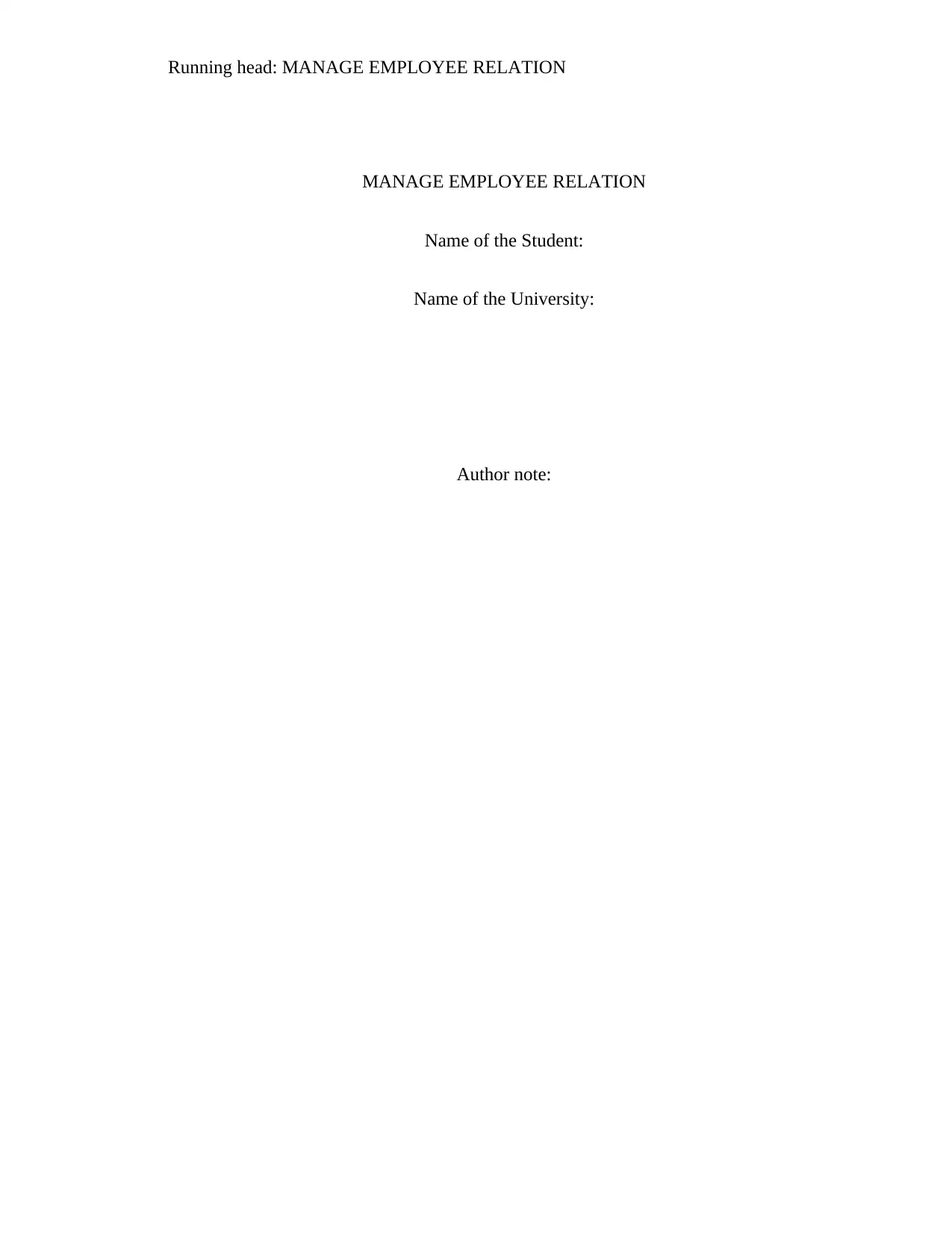
Running head: MANAGE EMPLOYEE RELATION
MANAGE EMPLOYEE RELATION
Name of the Student:
Name of the University:
Author note:
MANAGE EMPLOYEE RELATION
Name of the Student:
Name of the University:
Author note:
Paraphrase This Document
Need a fresh take? Get an instant paraphrase of this document with our AI Paraphraser
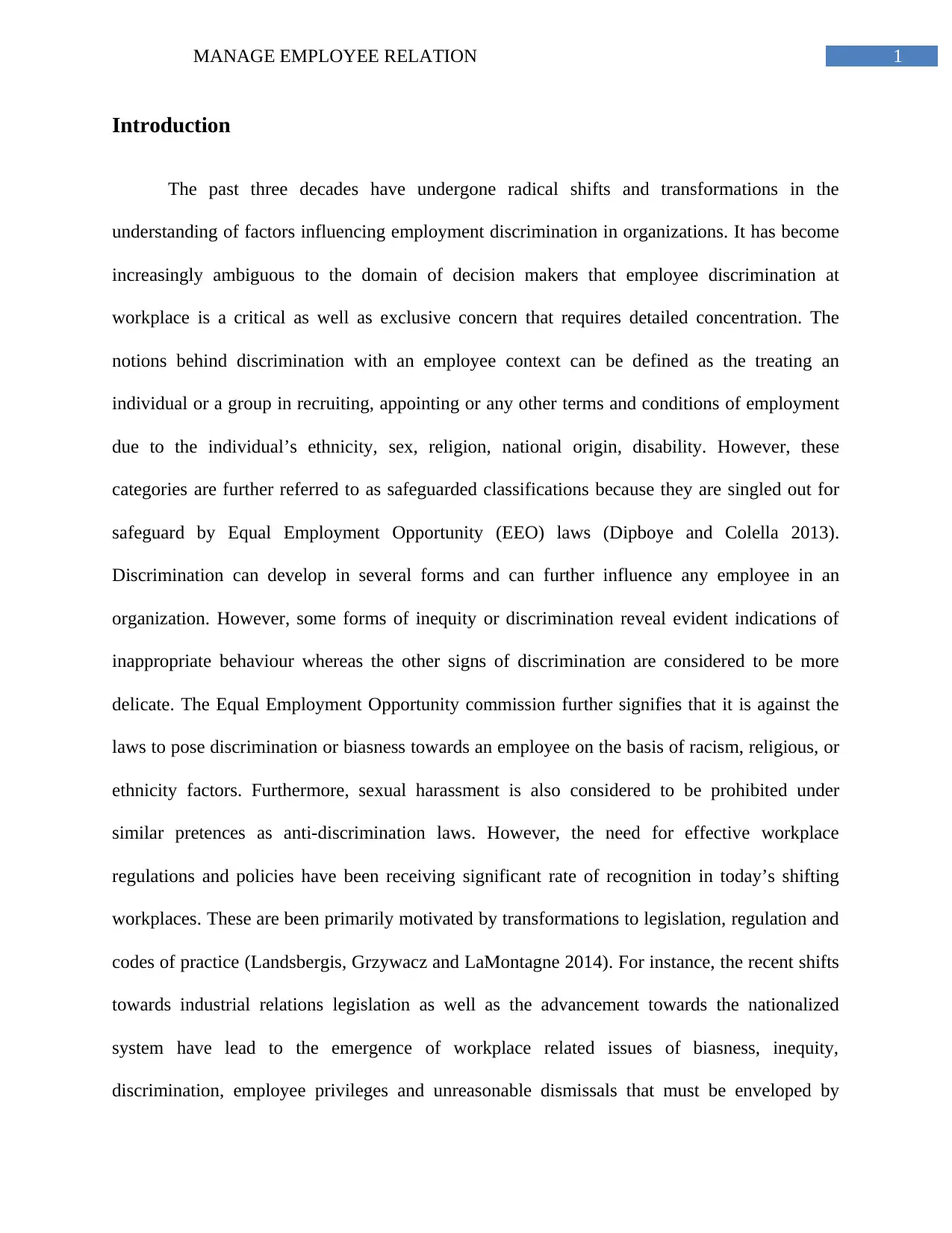
1MANAGE EMPLOYEE RELATION
Introduction
The past three decades have undergone radical shifts and transformations in the
understanding of factors influencing employment discrimination in organizations. It has become
increasingly ambiguous to the domain of decision makers that employee discrimination at
workplace is a critical as well as exclusive concern that requires detailed concentration. The
notions behind discrimination with an employee context can be defined as the treating an
individual or a group in recruiting, appointing or any other terms and conditions of employment
due to the individual’s ethnicity, sex, religion, national origin, disability. However, these
categories are further referred to as safeguarded classifications because they are singled out for
safeguard by Equal Employment Opportunity (EEO) laws (Dipboye and Colella 2013).
Discrimination can develop in several forms and can further influence any employee in an
organization. However, some forms of inequity or discrimination reveal evident indications of
inappropriate behaviour whereas the other signs of discrimination are considered to be more
delicate. The Equal Employment Opportunity commission further signifies that it is against the
laws to pose discrimination or biasness towards an employee on the basis of racism, religious, or
ethnicity factors. Furthermore, sexual harassment is also considered to be prohibited under
similar pretences as anti-discrimination laws. However, the need for effective workplace
regulations and policies have been receiving significant rate of recognition in today’s shifting
workplaces. These are been primarily motivated by transformations to legislation, regulation and
codes of practice (Landsbergis, Grzywacz and LaMontagne 2014). For instance, the recent shifts
towards industrial relations legislation as well as the advancement towards the nationalized
system have lead to the emergence of workplace related issues of biasness, inequity,
discrimination, employee privileges and unreasonable dismissals that must be enveloped by
Introduction
The past three decades have undergone radical shifts and transformations in the
understanding of factors influencing employment discrimination in organizations. It has become
increasingly ambiguous to the domain of decision makers that employee discrimination at
workplace is a critical as well as exclusive concern that requires detailed concentration. The
notions behind discrimination with an employee context can be defined as the treating an
individual or a group in recruiting, appointing or any other terms and conditions of employment
due to the individual’s ethnicity, sex, religion, national origin, disability. However, these
categories are further referred to as safeguarded classifications because they are singled out for
safeguard by Equal Employment Opportunity (EEO) laws (Dipboye and Colella 2013).
Discrimination can develop in several forms and can further influence any employee in an
organization. However, some forms of inequity or discrimination reveal evident indications of
inappropriate behaviour whereas the other signs of discrimination are considered to be more
delicate. The Equal Employment Opportunity commission further signifies that it is against the
laws to pose discrimination or biasness towards an employee on the basis of racism, religious, or
ethnicity factors. Furthermore, sexual harassment is also considered to be prohibited under
similar pretences as anti-discrimination laws. However, the need for effective workplace
regulations and policies have been receiving significant rate of recognition in today’s shifting
workplaces. These are been primarily motivated by transformations to legislation, regulation and
codes of practice (Landsbergis, Grzywacz and LaMontagne 2014). For instance, the recent shifts
towards industrial relations legislation as well as the advancement towards the nationalized
system have lead to the emergence of workplace related issues of biasness, inequity,
discrimination, employee privileges and unreasonable dismissals that must be enveloped by
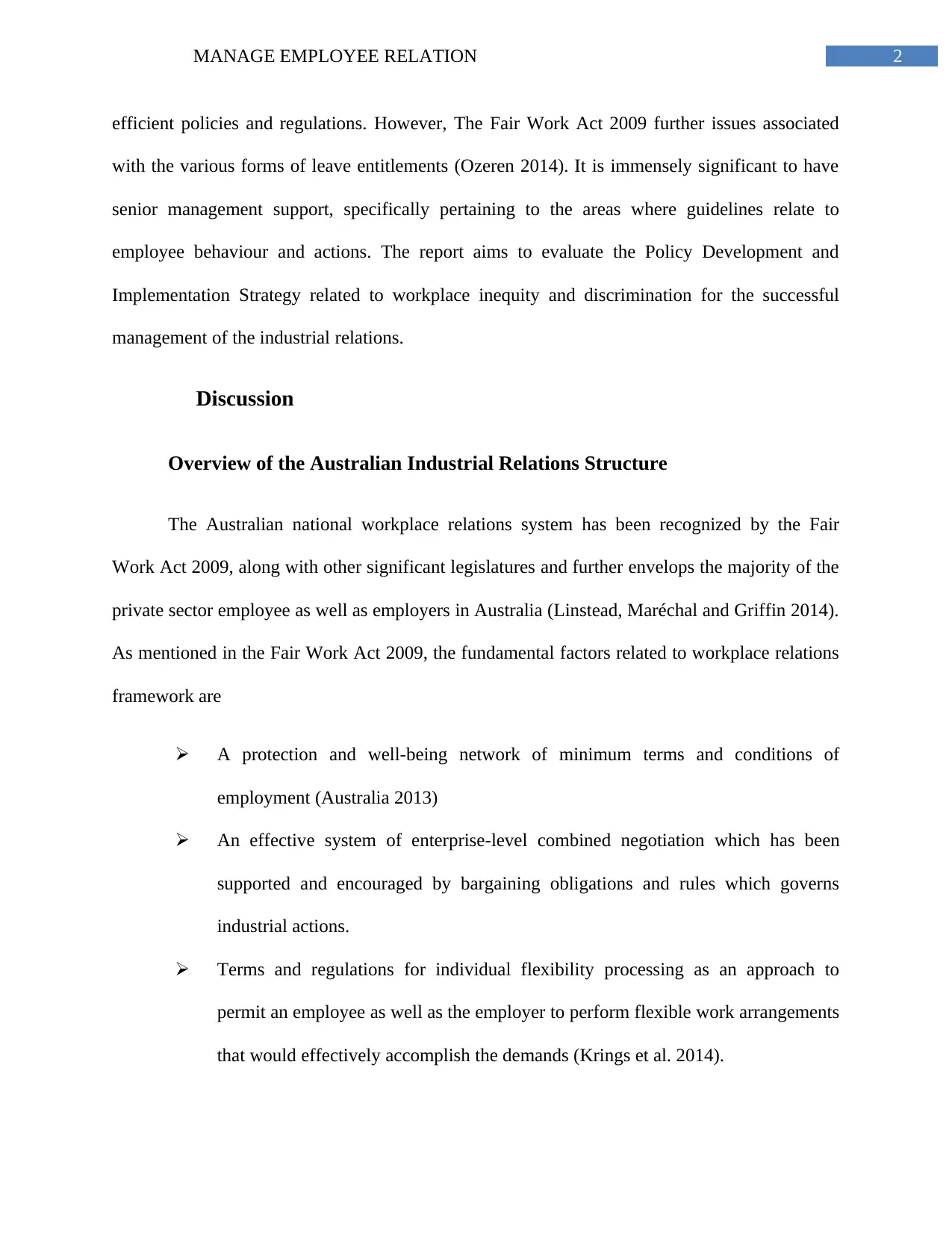
2MANAGE EMPLOYEE RELATION
efficient policies and regulations. However, The Fair Work Act 2009 further issues associated
with the various forms of leave entitlements (Ozeren 2014). It is immensely significant to have
senior management support, specifically pertaining to the areas where guidelines relate to
employee behaviour and actions. The report aims to evaluate the Policy Development and
Implementation Strategy related to workplace inequity and discrimination for the successful
management of the industrial relations.
Discussion
Overview of the Australian Industrial Relations Structure
The Australian national workplace relations system has been recognized by the Fair
Work Act 2009, along with other significant legislatures and further envelops the majority of the
private sector employee as well as employers in Australia (Linstead, Maréchal and Griffin 2014).
As mentioned in the Fair Work Act 2009, the fundamental factors related to workplace relations
framework are
A protection and well-being network of minimum terms and conditions of
employment (Australia 2013)
An effective system of enterprise-level combined negotiation which has been
supported and encouraged by bargaining obligations and rules which governs
industrial actions.
Terms and regulations for individual flexibility processing as an approach to
permit an employee as well as the employer to perform flexible work arrangements
that would effectively accomplish the demands (Krings et al. 2014).
efficient policies and regulations. However, The Fair Work Act 2009 further issues associated
with the various forms of leave entitlements (Ozeren 2014). It is immensely significant to have
senior management support, specifically pertaining to the areas where guidelines relate to
employee behaviour and actions. The report aims to evaluate the Policy Development and
Implementation Strategy related to workplace inequity and discrimination for the successful
management of the industrial relations.
Discussion
Overview of the Australian Industrial Relations Structure
The Australian national workplace relations system has been recognized by the Fair
Work Act 2009, along with other significant legislatures and further envelops the majority of the
private sector employee as well as employers in Australia (Linstead, Maréchal and Griffin 2014).
As mentioned in the Fair Work Act 2009, the fundamental factors related to workplace relations
framework are
A protection and well-being network of minimum terms and conditions of
employment (Australia 2013)
An effective system of enterprise-level combined negotiation which has been
supported and encouraged by bargaining obligations and rules which governs
industrial actions.
Terms and regulations for individual flexibility processing as an approach to
permit an employee as well as the employer to perform flexible work arrangements
that would effectively accomplish the demands (Krings et al. 2014).
⊘ This is a preview!⊘
Do you want full access?
Subscribe today to unlock all pages.

Trusted by 1+ million students worldwide
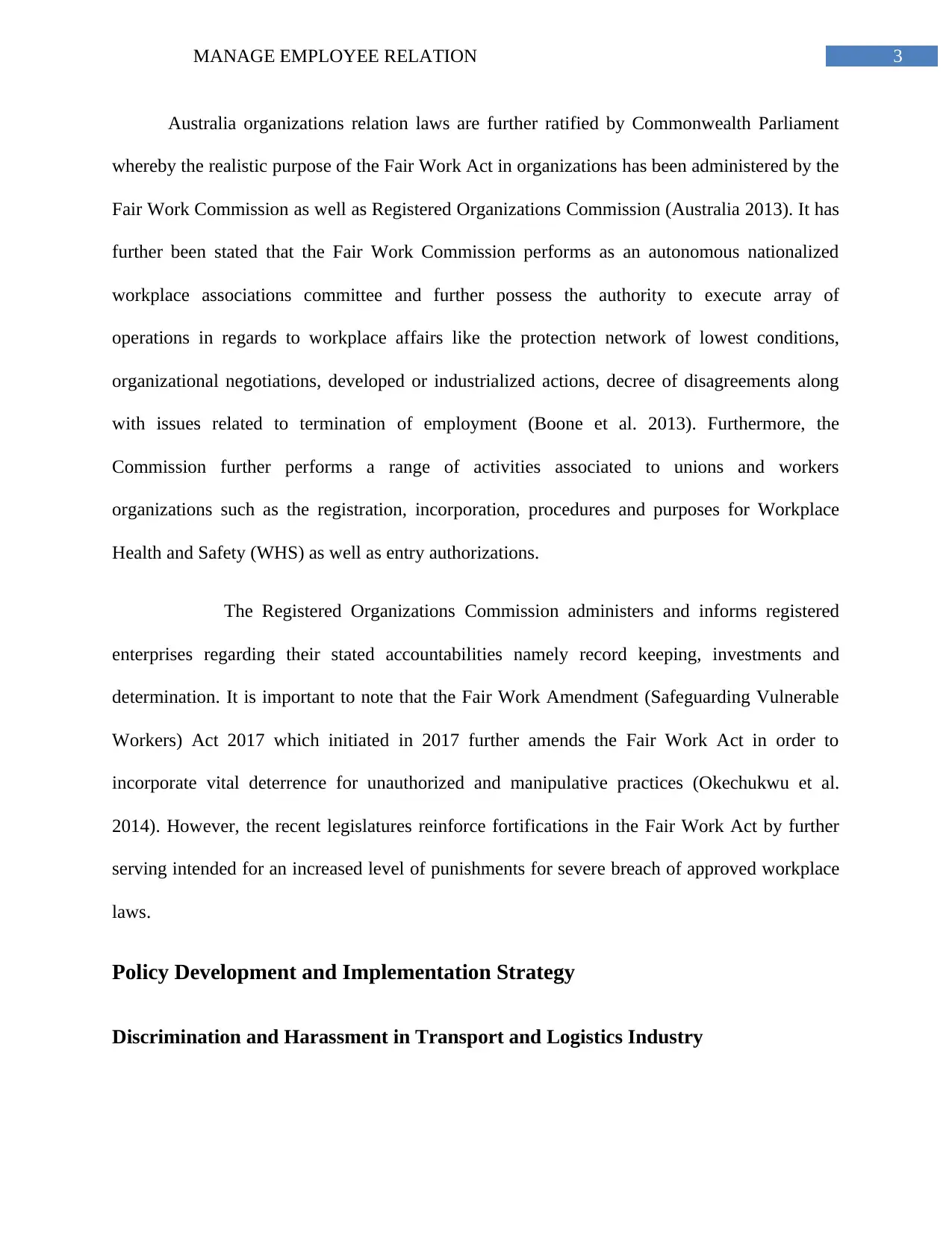
3MANAGE EMPLOYEE RELATION
Australia organizations relation laws are further ratified by Commonwealth Parliament
whereby the realistic purpose of the Fair Work Act in organizations has been administered by the
Fair Work Commission as well as Registered Organizations Commission (Australia 2013). It has
further been stated that the Fair Work Commission performs as an autonomous nationalized
workplace associations committee and further possess the authority to execute array of
operations in regards to workplace affairs like the protection network of lowest conditions,
organizational negotiations, developed or industrialized actions, decree of disagreements along
with issues related to termination of employment (Boone et al. 2013). Furthermore, the
Commission further performs a range of activities associated to unions and workers
organizations such as the registration, incorporation, procedures and purposes for Workplace
Health and Safety (WHS) as well as entry authorizations.
The Registered Organizations Commission administers and informs registered
enterprises regarding their stated accountabilities namely record keeping, investments and
determination. It is important to note that the Fair Work Amendment (Safeguarding Vulnerable
Workers) Act 2017 which initiated in 2017 further amends the Fair Work Act in order to
incorporate vital deterrence for unauthorized and manipulative practices (Okechukwu et al.
2014). However, the recent legislatures reinforce fortifications in the Fair Work Act by further
serving intended for an increased level of punishments for severe breach of approved workplace
laws.
Policy Development and Implementation Strategy
Discrimination and Harassment in Transport and Logistics Industry
Australia organizations relation laws are further ratified by Commonwealth Parliament
whereby the realistic purpose of the Fair Work Act in organizations has been administered by the
Fair Work Commission as well as Registered Organizations Commission (Australia 2013). It has
further been stated that the Fair Work Commission performs as an autonomous nationalized
workplace associations committee and further possess the authority to execute array of
operations in regards to workplace affairs like the protection network of lowest conditions,
organizational negotiations, developed or industrialized actions, decree of disagreements along
with issues related to termination of employment (Boone et al. 2013). Furthermore, the
Commission further performs a range of activities associated to unions and workers
organizations such as the registration, incorporation, procedures and purposes for Workplace
Health and Safety (WHS) as well as entry authorizations.
The Registered Organizations Commission administers and informs registered
enterprises regarding their stated accountabilities namely record keeping, investments and
determination. It is important to note that the Fair Work Amendment (Safeguarding Vulnerable
Workers) Act 2017 which initiated in 2017 further amends the Fair Work Act in order to
incorporate vital deterrence for unauthorized and manipulative practices (Okechukwu et al.
2014). However, the recent legislatures reinforce fortifications in the Fair Work Act by further
serving intended for an increased level of punishments for severe breach of approved workplace
laws.
Policy Development and Implementation Strategy
Discrimination and Harassment in Transport and Logistics Industry
Paraphrase This Document
Need a fresh take? Get an instant paraphrase of this document with our AI Paraphraser
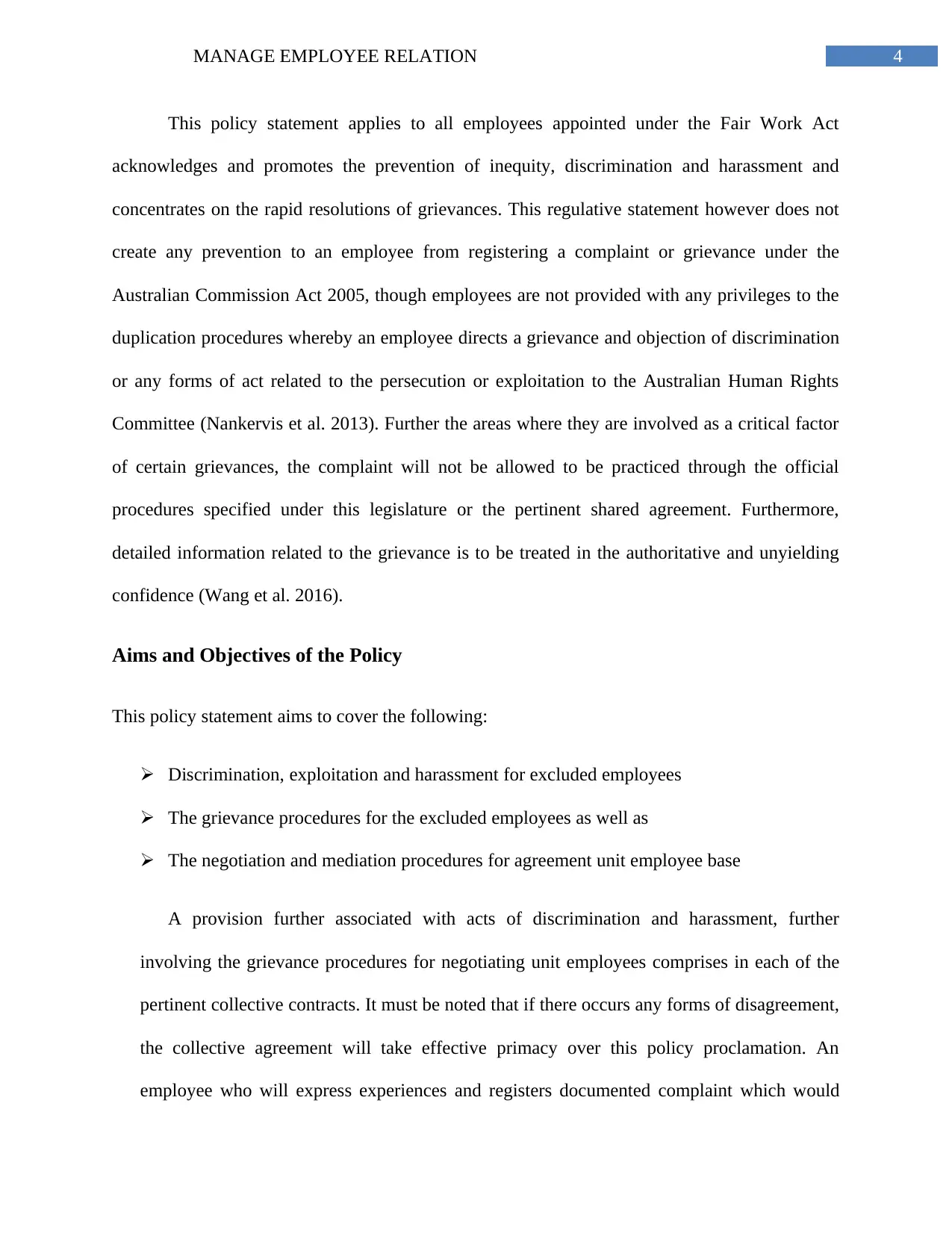
4MANAGE EMPLOYEE RELATION
This policy statement applies to all employees appointed under the Fair Work Act
acknowledges and promotes the prevention of inequity, discrimination and harassment and
concentrates on the rapid resolutions of grievances. This regulative statement however does not
create any prevention to an employee from registering a complaint or grievance under the
Australian Commission Act 2005, though employees are not provided with any privileges to the
duplication procedures whereby an employee directs a grievance and objection of discrimination
or any forms of act related to the persecution or exploitation to the Australian Human Rights
Committee (Nankervis et al. 2013). Further the areas where they are involved as a critical factor
of certain grievances, the complaint will not be allowed to be practiced through the official
procedures specified under this legislature or the pertinent shared agreement. Furthermore,
detailed information related to the grievance is to be treated in the authoritative and unyielding
confidence (Wang et al. 2016).
Aims and Objectives of the Policy
This policy statement aims to cover the following:
Discrimination, exploitation and harassment for excluded employees
The grievance procedures for the excluded employees as well as
The negotiation and mediation procedures for agreement unit employee base
A provision further associated with acts of discrimination and harassment, further
involving the grievance procedures for negotiating unit employees comprises in each of the
pertinent collective contracts. It must be noted that if there occurs any forms of disagreement,
the collective agreement will take effective primacy over this policy proclamation. An
employee who will express experiences and registers documented complaint which would
This policy statement applies to all employees appointed under the Fair Work Act
acknowledges and promotes the prevention of inequity, discrimination and harassment and
concentrates on the rapid resolutions of grievances. This regulative statement however does not
create any prevention to an employee from registering a complaint or grievance under the
Australian Commission Act 2005, though employees are not provided with any privileges to the
duplication procedures whereby an employee directs a grievance and objection of discrimination
or any forms of act related to the persecution or exploitation to the Australian Human Rights
Committee (Nankervis et al. 2013). Further the areas where they are involved as a critical factor
of certain grievances, the complaint will not be allowed to be practiced through the official
procedures specified under this legislature or the pertinent shared agreement. Furthermore,
detailed information related to the grievance is to be treated in the authoritative and unyielding
confidence (Wang et al. 2016).
Aims and Objectives of the Policy
This policy statement aims to cover the following:
Discrimination, exploitation and harassment for excluded employees
The grievance procedures for the excluded employees as well as
The negotiation and mediation procedures for agreement unit employee base
A provision further associated with acts of discrimination and harassment, further
involving the grievance procedures for negotiating unit employees comprises in each of the
pertinent collective contracts. It must be noted that if there occurs any forms of disagreement,
the collective agreement will take effective primacy over this policy proclamation. An
employee who will express experiences and registers documented complaint which would
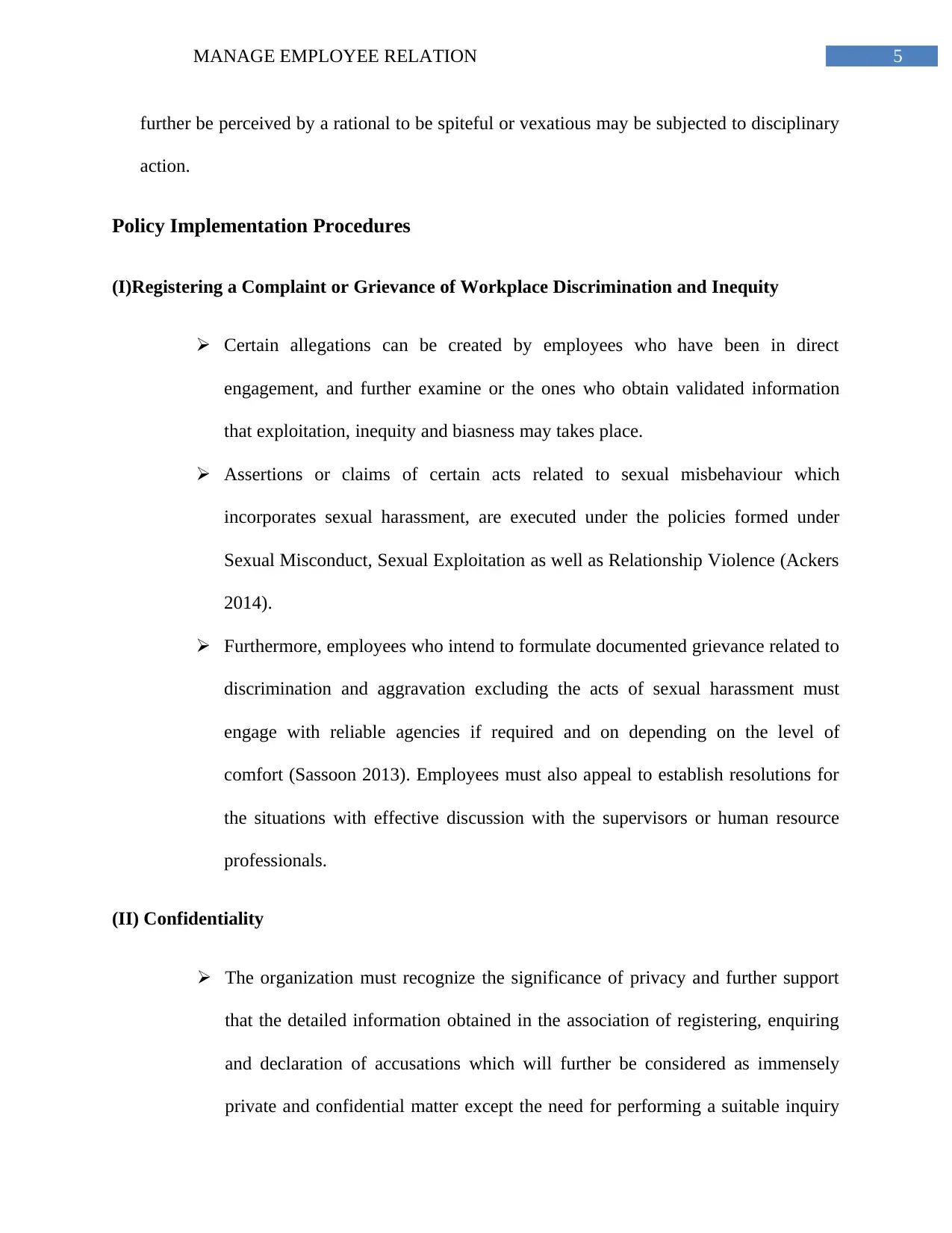
5MANAGE EMPLOYEE RELATION
further be perceived by a rational to be spiteful or vexatious may be subjected to disciplinary
action.
Policy Implementation Procedures
(I)Registering a Complaint or Grievance of Workplace Discrimination and Inequity
Certain allegations can be created by employees who have been in direct
engagement, and further examine or the ones who obtain validated information
that exploitation, inequity and biasness may takes place.
Assertions or claims of certain acts related to sexual misbehaviour which
incorporates sexual harassment, are executed under the policies formed under
Sexual Misconduct, Sexual Exploitation as well as Relationship Violence (Ackers
2014).
Furthermore, employees who intend to formulate documented grievance related to
discrimination and aggravation excluding the acts of sexual harassment must
engage with reliable agencies if required and on depending on the level of
comfort (Sassoon 2013). Employees must also appeal to establish resolutions for
the situations with effective discussion with the supervisors or human resource
professionals.
(II) Confidentiality
The organization must recognize the significance of privacy and further support
that the detailed information obtained in the association of registering, enquiring
and declaration of accusations which will further be considered as immensely
private and confidential matter except the need for performing a suitable inquiry
further be perceived by a rational to be spiteful or vexatious may be subjected to disciplinary
action.
Policy Implementation Procedures
(I)Registering a Complaint or Grievance of Workplace Discrimination and Inequity
Certain allegations can be created by employees who have been in direct
engagement, and further examine or the ones who obtain validated information
that exploitation, inequity and biasness may takes place.
Assertions or claims of certain acts related to sexual misbehaviour which
incorporates sexual harassment, are executed under the policies formed under
Sexual Misconduct, Sexual Exploitation as well as Relationship Violence (Ackers
2014).
Furthermore, employees who intend to formulate documented grievance related to
discrimination and aggravation excluding the acts of sexual harassment must
engage with reliable agencies if required and on depending on the level of
comfort (Sassoon 2013). Employees must also appeal to establish resolutions for
the situations with effective discussion with the supervisors or human resource
professionals.
(II) Confidentiality
The organization must recognize the significance of privacy and further support
that the detailed information obtained in the association of registering, enquiring
and declaration of accusations which will further be considered as immensely
private and confidential matter except the need for performing a suitable inquiry
⊘ This is a preview!⊘
Do you want full access?
Subscribe today to unlock all pages.

Trusted by 1+ million students worldwide
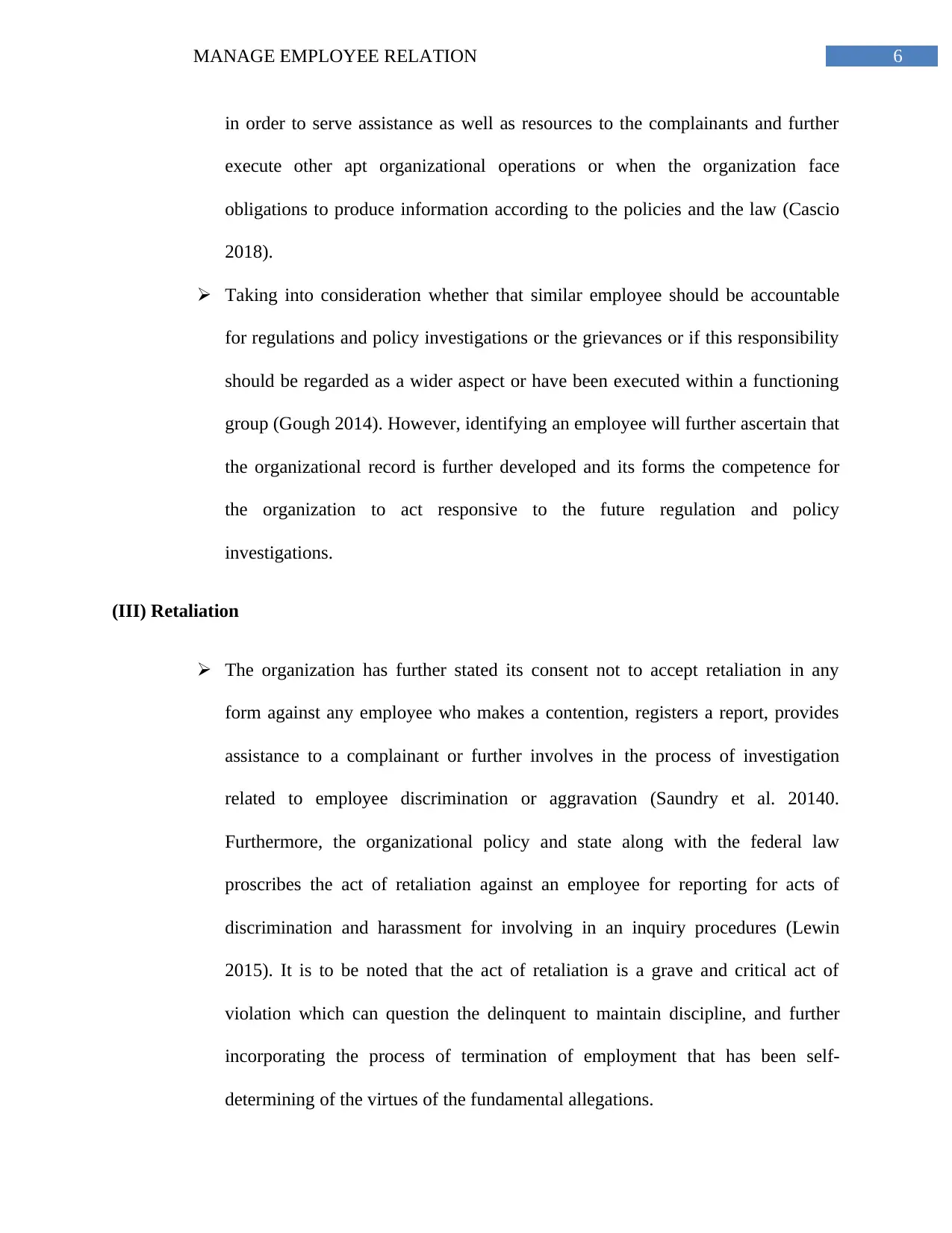
6MANAGE EMPLOYEE RELATION
in order to serve assistance as well as resources to the complainants and further
execute other apt organizational operations or when the organization face
obligations to produce information according to the policies and the law (Cascio
2018).
Taking into consideration whether that similar employee should be accountable
for regulations and policy investigations or the grievances or if this responsibility
should be regarded as a wider aspect or have been executed within a functioning
group (Gough 2014). However, identifying an employee will further ascertain that
the organizational record is further developed and its forms the competence for
the organization to act responsive to the future regulation and policy
investigations.
(III) Retaliation
The organization has further stated its consent not to accept retaliation in any
form against any employee who makes a contention, registers a report, provides
assistance to a complainant or further involves in the process of investigation
related to employee discrimination or aggravation (Saundry et al. 20140.
Furthermore, the organizational policy and state along with the federal law
proscribes the act of retaliation against an employee for reporting for acts of
discrimination and harassment for involving in an inquiry procedures (Lewin
2015). It is to be noted that the act of retaliation is a grave and critical act of
violation which can question the delinquent to maintain discipline, and further
incorporating the process of termination of employment that has been self-
determining of the virtues of the fundamental allegations.
in order to serve assistance as well as resources to the complainants and further
execute other apt organizational operations or when the organization face
obligations to produce information according to the policies and the law (Cascio
2018).
Taking into consideration whether that similar employee should be accountable
for regulations and policy investigations or the grievances or if this responsibility
should be regarded as a wider aspect or have been executed within a functioning
group (Gough 2014). However, identifying an employee will further ascertain that
the organizational record is further developed and its forms the competence for
the organization to act responsive to the future regulation and policy
investigations.
(III) Retaliation
The organization has further stated its consent not to accept retaliation in any
form against any employee who makes a contention, registers a report, provides
assistance to a complainant or further involves in the process of investigation
related to employee discrimination or aggravation (Saundry et al. 20140.
Furthermore, the organizational policy and state along with the federal law
proscribes the act of retaliation against an employee for reporting for acts of
discrimination and harassment for involving in an inquiry procedures (Lewin
2015). It is to be noted that the act of retaliation is a grave and critical act of
violation which can question the delinquent to maintain discipline, and further
incorporating the process of termination of employment that has been self-
determining of the virtues of the fundamental allegations.
Paraphrase This Document
Need a fresh take? Get an instant paraphrase of this document with our AI Paraphraser
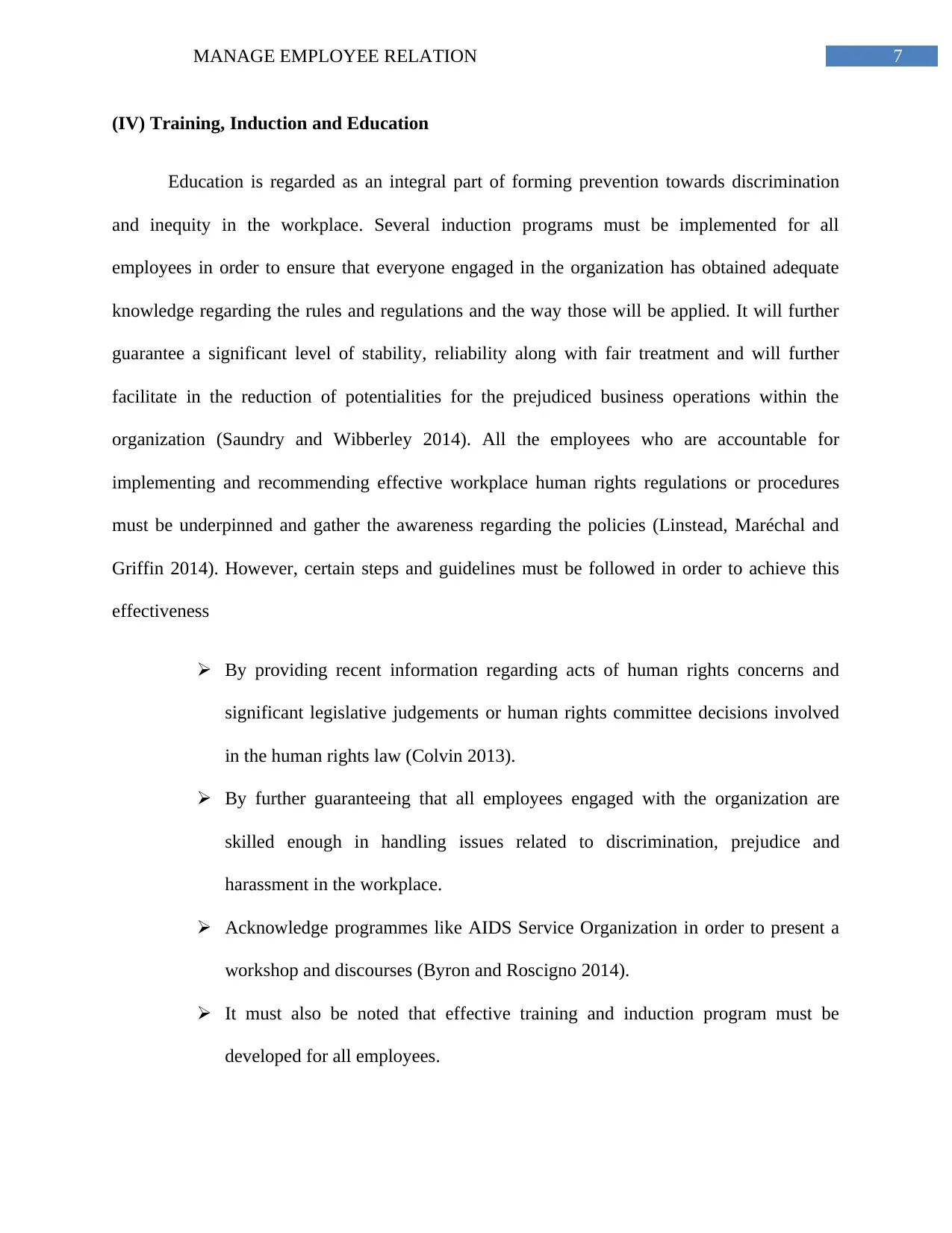
7MANAGE EMPLOYEE RELATION
(IV) Training, Induction and Education
Education is regarded as an integral part of forming prevention towards discrimination
and inequity in the workplace. Several induction programs must be implemented for all
employees in order to ensure that everyone engaged in the organization has obtained adequate
knowledge regarding the rules and regulations and the way those will be applied. It will further
guarantee a significant level of stability, reliability along with fair treatment and will further
facilitate in the reduction of potentialities for the prejudiced business operations within the
organization (Saundry and Wibberley 2014). All the employees who are accountable for
implementing and recommending effective workplace human rights regulations or procedures
must be underpinned and gather the awareness regarding the policies (Linstead, Maréchal and
Griffin 2014). However, certain steps and guidelines must be followed in order to achieve this
effectiveness
By providing recent information regarding acts of human rights concerns and
significant legislative judgements or human rights committee decisions involved
in the human rights law (Colvin 2013).
By further guaranteeing that all employees engaged with the organization are
skilled enough in handling issues related to discrimination, prejudice and
harassment in the workplace.
Acknowledge programmes like AIDS Service Organization in order to present a
workshop and discourses (Byron and Roscigno 2014).
It must also be noted that effective training and induction program must be
developed for all employees.
(IV) Training, Induction and Education
Education is regarded as an integral part of forming prevention towards discrimination
and inequity in the workplace. Several induction programs must be implemented for all
employees in order to ensure that everyone engaged in the organization has obtained adequate
knowledge regarding the rules and regulations and the way those will be applied. It will further
guarantee a significant level of stability, reliability along with fair treatment and will further
facilitate in the reduction of potentialities for the prejudiced business operations within the
organization (Saundry and Wibberley 2014). All the employees who are accountable for
implementing and recommending effective workplace human rights regulations or procedures
must be underpinned and gather the awareness regarding the policies (Linstead, Maréchal and
Griffin 2014). However, certain steps and guidelines must be followed in order to achieve this
effectiveness
By providing recent information regarding acts of human rights concerns and
significant legislative judgements or human rights committee decisions involved
in the human rights law (Colvin 2013).
By further guaranteeing that all employees engaged with the organization are
skilled enough in handling issues related to discrimination, prejudice and
harassment in the workplace.
Acknowledge programmes like AIDS Service Organization in order to present a
workshop and discourses (Byron and Roscigno 2014).
It must also be noted that effective training and induction program must be
developed for all employees.
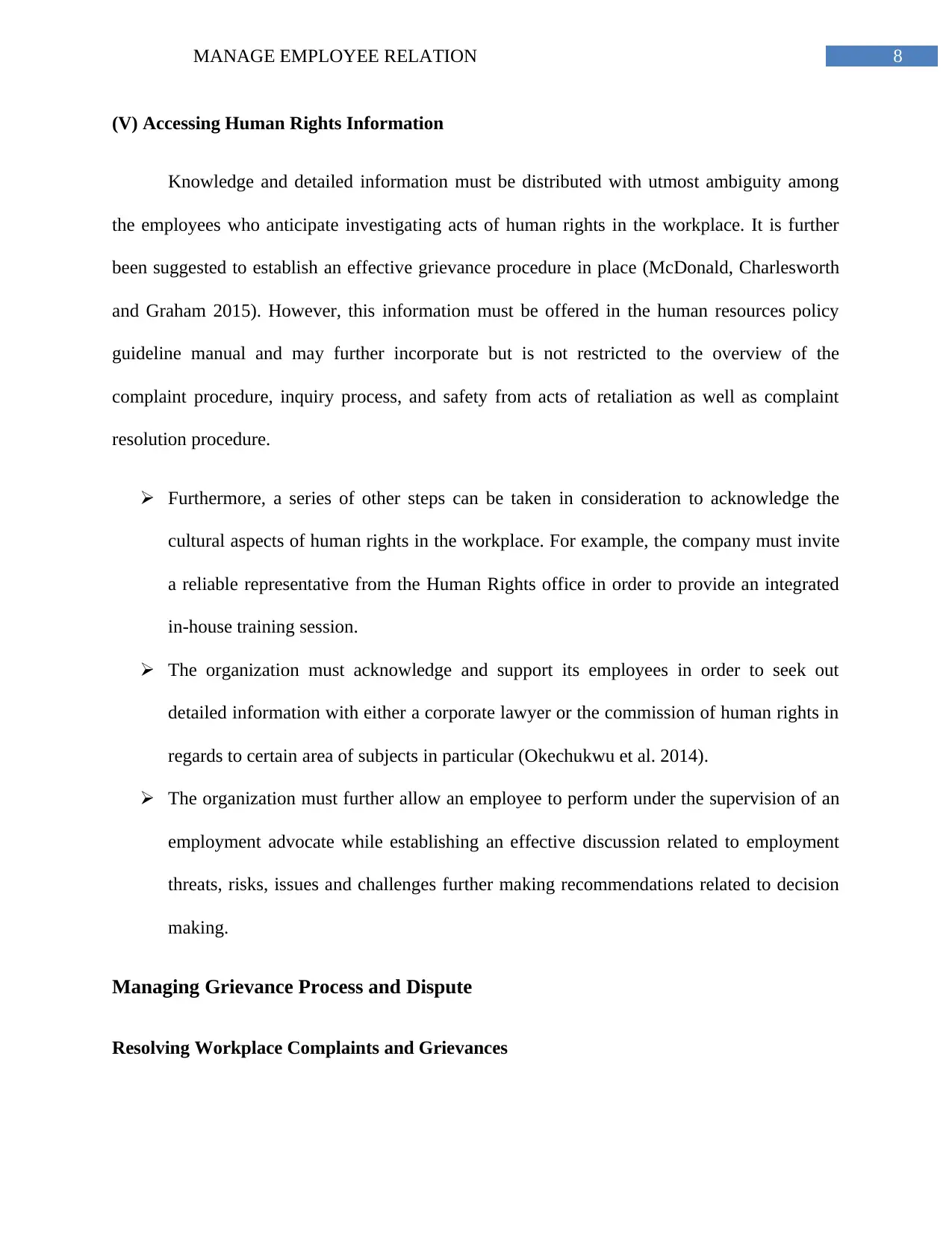
8MANAGE EMPLOYEE RELATION
(V) Accessing Human Rights Information
Knowledge and detailed information must be distributed with utmost ambiguity among
the employees who anticipate investigating acts of human rights in the workplace. It is further
been suggested to establish an effective grievance procedure in place (McDonald, Charlesworth
and Graham 2015). However, this information must be offered in the human resources policy
guideline manual and may further incorporate but is not restricted to the overview of the
complaint procedure, inquiry process, and safety from acts of retaliation as well as complaint
resolution procedure.
Furthermore, a series of other steps can be taken in consideration to acknowledge the
cultural aspects of human rights in the workplace. For example, the company must invite
a reliable representative from the Human Rights office in order to provide an integrated
in-house training session.
The organization must acknowledge and support its employees in order to seek out
detailed information with either a corporate lawyer or the commission of human rights in
regards to certain area of subjects in particular (Okechukwu et al. 2014).
The organization must further allow an employee to perform under the supervision of an
employment advocate while establishing an effective discussion related to employment
threats, risks, issues and challenges further making recommendations related to decision
making.
Managing Grievance Process and Dispute
Resolving Workplace Complaints and Grievances
(V) Accessing Human Rights Information
Knowledge and detailed information must be distributed with utmost ambiguity among
the employees who anticipate investigating acts of human rights in the workplace. It is further
been suggested to establish an effective grievance procedure in place (McDonald, Charlesworth
and Graham 2015). However, this information must be offered in the human resources policy
guideline manual and may further incorporate but is not restricted to the overview of the
complaint procedure, inquiry process, and safety from acts of retaliation as well as complaint
resolution procedure.
Furthermore, a series of other steps can be taken in consideration to acknowledge the
cultural aspects of human rights in the workplace. For example, the company must invite
a reliable representative from the Human Rights office in order to provide an integrated
in-house training session.
The organization must acknowledge and support its employees in order to seek out
detailed information with either a corporate lawyer or the commission of human rights in
regards to certain area of subjects in particular (Okechukwu et al. 2014).
The organization must further allow an employee to perform under the supervision of an
employment advocate while establishing an effective discussion related to employment
threats, risks, issues and challenges further making recommendations related to decision
making.
Managing Grievance Process and Dispute
Resolving Workplace Complaints and Grievances
⊘ This is a preview!⊘
Do you want full access?
Subscribe today to unlock all pages.

Trusted by 1+ million students worldwide
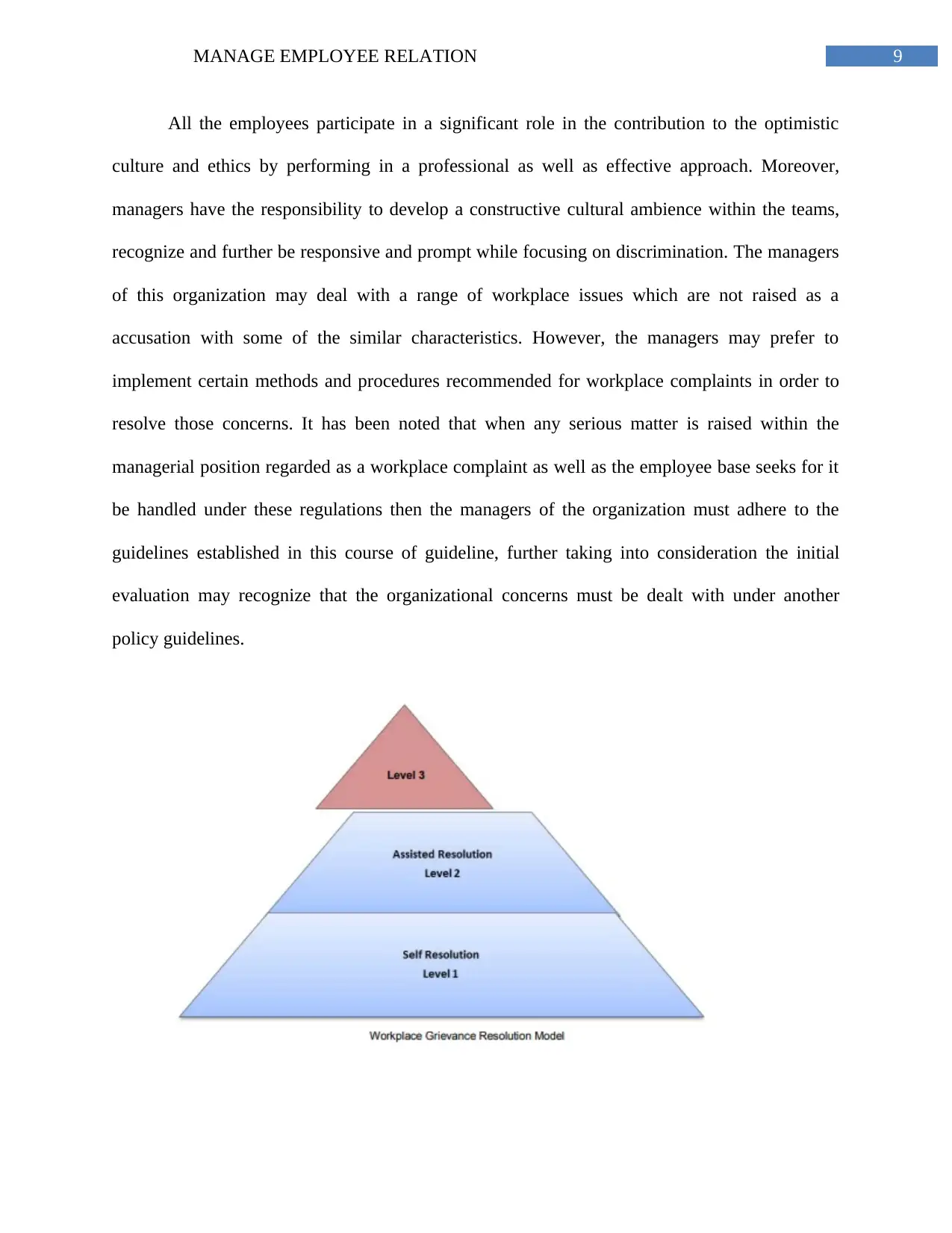
9MANAGE EMPLOYEE RELATION
All the employees participate in a significant role in the contribution to the optimistic
culture and ethics by performing in a professional as well as effective approach. Moreover,
managers have the responsibility to develop a constructive cultural ambience within the teams,
recognize and further be responsive and prompt while focusing on discrimination. The managers
of this organization may deal with a range of workplace issues which are not raised as a
accusation with some of the similar characteristics. However, the managers may prefer to
implement certain methods and procedures recommended for workplace complaints in order to
resolve those concerns. It has been noted that when any serious matter is raised within the
managerial position regarded as a workplace complaint as well as the employee base seeks for it
be handled under these regulations then the managers of the organization must adhere to the
guidelines established in this course of guideline, further taking into consideration the initial
evaluation may recognize that the organizational concerns must be dealt with under another
policy guidelines.
All the employees participate in a significant role in the contribution to the optimistic
culture and ethics by performing in a professional as well as effective approach. Moreover,
managers have the responsibility to develop a constructive cultural ambience within the teams,
recognize and further be responsive and prompt while focusing on discrimination. The managers
of this organization may deal with a range of workplace issues which are not raised as a
accusation with some of the similar characteristics. However, the managers may prefer to
implement certain methods and procedures recommended for workplace complaints in order to
resolve those concerns. It has been noted that when any serious matter is raised within the
managerial position regarded as a workplace complaint as well as the employee base seeks for it
be handled under these regulations then the managers of the organization must adhere to the
guidelines established in this course of guideline, further taking into consideration the initial
evaluation may recognize that the organizational concerns must be dealt with under another
policy guidelines.
Paraphrase This Document
Need a fresh take? Get an instant paraphrase of this document with our AI Paraphraser
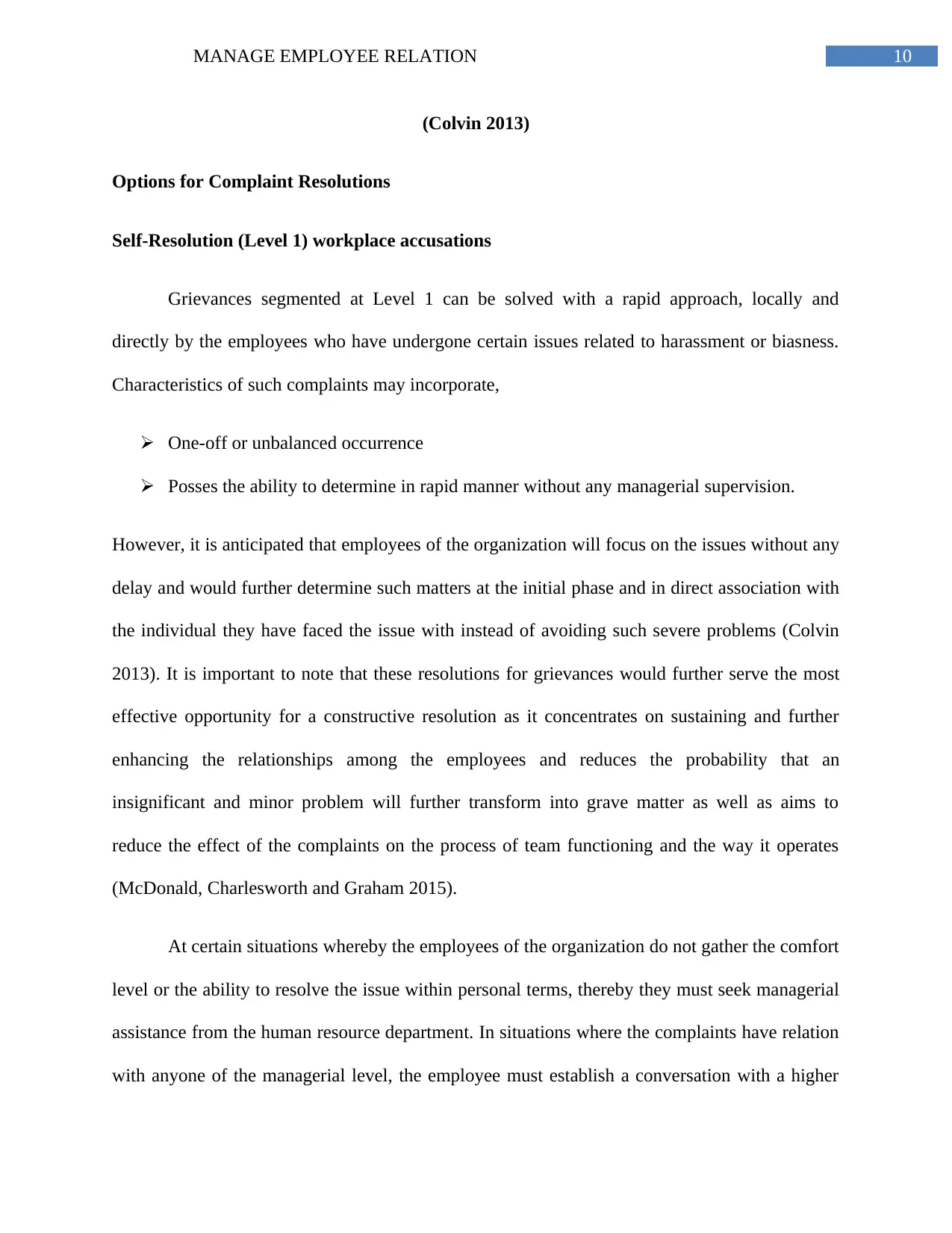
10MANAGE EMPLOYEE RELATION
(Colvin 2013)
Options for Complaint Resolutions
Self-Resolution (Level 1) workplace accusations
Grievances segmented at Level 1 can be solved with a rapid approach, locally and
directly by the employees who have undergone certain issues related to harassment or biasness.
Characteristics of such complaints may incorporate,
One-off or unbalanced occurrence
Posses the ability to determine in rapid manner without any managerial supervision.
However, it is anticipated that employees of the organization will focus on the issues without any
delay and would further determine such matters at the initial phase and in direct association with
the individual they have faced the issue with instead of avoiding such severe problems (Colvin
2013). It is important to note that these resolutions for grievances would further serve the most
effective opportunity for a constructive resolution as it concentrates on sustaining and further
enhancing the relationships among the employees and reduces the probability that an
insignificant and minor problem will further transform into grave matter as well as aims to
reduce the effect of the complaints on the process of team functioning and the way it operates
(McDonald, Charlesworth and Graham 2015).
At certain situations whereby the employees of the organization do not gather the comfort
level or the ability to resolve the issue within personal terms, thereby they must seek managerial
assistance from the human resource department. In situations where the complaints have relation
with anyone of the managerial level, the employee must establish a conversation with a higher
(Colvin 2013)
Options for Complaint Resolutions
Self-Resolution (Level 1) workplace accusations
Grievances segmented at Level 1 can be solved with a rapid approach, locally and
directly by the employees who have undergone certain issues related to harassment or biasness.
Characteristics of such complaints may incorporate,
One-off or unbalanced occurrence
Posses the ability to determine in rapid manner without any managerial supervision.
However, it is anticipated that employees of the organization will focus on the issues without any
delay and would further determine such matters at the initial phase and in direct association with
the individual they have faced the issue with instead of avoiding such severe problems (Colvin
2013). It is important to note that these resolutions for grievances would further serve the most
effective opportunity for a constructive resolution as it concentrates on sustaining and further
enhancing the relationships among the employees and reduces the probability that an
insignificant and minor problem will further transform into grave matter as well as aims to
reduce the effect of the complaints on the process of team functioning and the way it operates
(McDonald, Charlesworth and Graham 2015).
At certain situations whereby the employees of the organization do not gather the comfort
level or the ability to resolve the issue within personal terms, thereby they must seek managerial
assistance from the human resource department. In situations where the complaints have relation
with anyone of the managerial level, the employee must establish a conversation with a higher
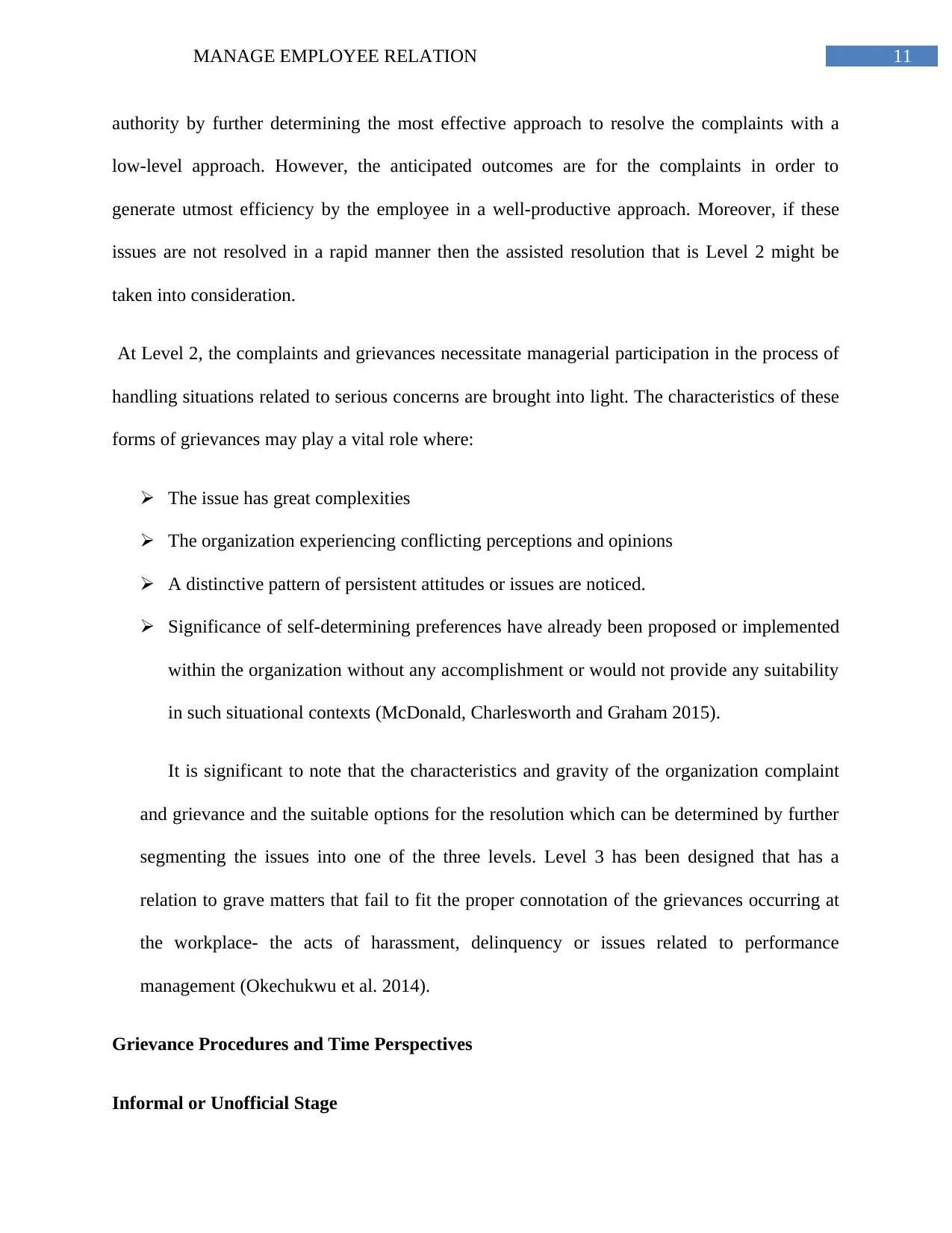
11MANAGE EMPLOYEE RELATION
authority by further determining the most effective approach to resolve the complaints with a
low-level approach. However, the anticipated outcomes are for the complaints in order to
generate utmost efficiency by the employee in a well-productive approach. Moreover, if these
issues are not resolved in a rapid manner then the assisted resolution that is Level 2 might be
taken into consideration.
At Level 2, the complaints and grievances necessitate managerial participation in the process of
handling situations related to serious concerns are brought into light. The characteristics of these
forms of grievances may play a vital role where:
The issue has great complexities
The organization experiencing conflicting perceptions and opinions
A distinctive pattern of persistent attitudes or issues are noticed.
Significance of self-determining preferences have already been proposed or implemented
within the organization without any accomplishment or would not provide any suitability
in such situational contexts (McDonald, Charlesworth and Graham 2015).
It is significant to note that the characteristics and gravity of the organization complaint
and grievance and the suitable options for the resolution which can be determined by further
segmenting the issues into one of the three levels. Level 3 has been designed that has a
relation to grave matters that fail to fit the proper connotation of the grievances occurring at
the workplace- the acts of harassment, delinquency or issues related to performance
management (Okechukwu et al. 2014).
Grievance Procedures and Time Perspectives
Informal or Unofficial Stage
authority by further determining the most effective approach to resolve the complaints with a
low-level approach. However, the anticipated outcomes are for the complaints in order to
generate utmost efficiency by the employee in a well-productive approach. Moreover, if these
issues are not resolved in a rapid manner then the assisted resolution that is Level 2 might be
taken into consideration.
At Level 2, the complaints and grievances necessitate managerial participation in the process of
handling situations related to serious concerns are brought into light. The characteristics of these
forms of grievances may play a vital role where:
The issue has great complexities
The organization experiencing conflicting perceptions and opinions
A distinctive pattern of persistent attitudes or issues are noticed.
Significance of self-determining preferences have already been proposed or implemented
within the organization without any accomplishment or would not provide any suitability
in such situational contexts (McDonald, Charlesworth and Graham 2015).
It is significant to note that the characteristics and gravity of the organization complaint
and grievance and the suitable options for the resolution which can be determined by further
segmenting the issues into one of the three levels. Level 3 has been designed that has a
relation to grave matters that fail to fit the proper connotation of the grievances occurring at
the workplace- the acts of harassment, delinquency or issues related to performance
management (Okechukwu et al. 2014).
Grievance Procedures and Time Perspectives
Informal or Unofficial Stage
⊘ This is a preview!⊘
Do you want full access?
Subscribe today to unlock all pages.

Trusted by 1+ million students worldwide
1 out of 18
Related Documents
Your All-in-One AI-Powered Toolkit for Academic Success.
+13062052269
info@desklib.com
Available 24*7 on WhatsApp / Email
![[object Object]](/_next/static/media/star-bottom.7253800d.svg)
Unlock your academic potential
Copyright © 2020–2025 A2Z Services. All Rights Reserved. Developed and managed by ZUCOL.





